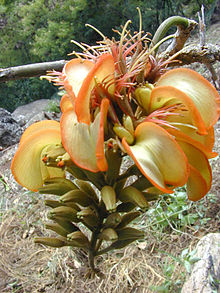Wiliwili
| Wiliwili Erythrina sandwicensis |
|
|---|---|
 |
|
| Raceme of wiliwili | |
| Scientific classification | |
| Kingdom: | Plantae |
| (unranked): | Angiosperms |
| (unranked): | Eudicots |
| (unranked): | Rosids |
| Order: | Fabales |
| Family: | Fabaceae |
| Genus: | Erythrina |
| Species: | E. sandwicensis |
| Binomial name | |
|
Erythrina sandwicensis O.Deg. |
|
Wiliwili, with the scientific name Erythrina sandwicensis, is a species of flowering tree in the pea family, Fabaceae that is endemic to the Hawaiian Islands. It is the only species of Erythrina that naturally occurs there. It is typically found in Hawaiian tropical dry forests on leeward island slopes up to an elevation of 600 m (2,000 ft).
Wiliwili means "repeatedly twisted" in the Hawaiian language and refers to the seedpods, which dehisce, or twist open, to reveal the seeds.
Wiliwili trees grow to a height of 4.5–9 m (15–30 ft) with a gnarled and stout trunk that reaches 0.3–0.9 m (0.98–2.95 ft) in diameter. The bark is smooth, slightly fissured, and covered in gray or black spines up to 1 cm (0.39 in) in length. The bark on the main trunk of mature trees has a distinct orange cast, which is caused by a terrestrial alga.
The wiliwili is summer (dry season) drought deciduous. The dry season usually begins in late April or in May, and trees in the wild typically lose all of their leaves before they bloom. Trees in cultivation may retain much of their foliage through blooming time. The flowers appear in the first half of the dry season, from April through July. They form on horizontal or nearly horizontal racemes that are 7.5–15 cm (3.0–5.9 in) long. The flower color may be orange, yellow, salmon, greenish or whitish. Sometimes all of these colors occur in a single population. The standard petal is erect, not enclosing the other petals. Like all of the erythrinas, the wiliwili is pollinated by birds. The horizontal raceme and the erect standard are adaptations to pollination by passerine birds. Many other erythrinas are pollinated by hummingbirds.
...
Wikipedia
